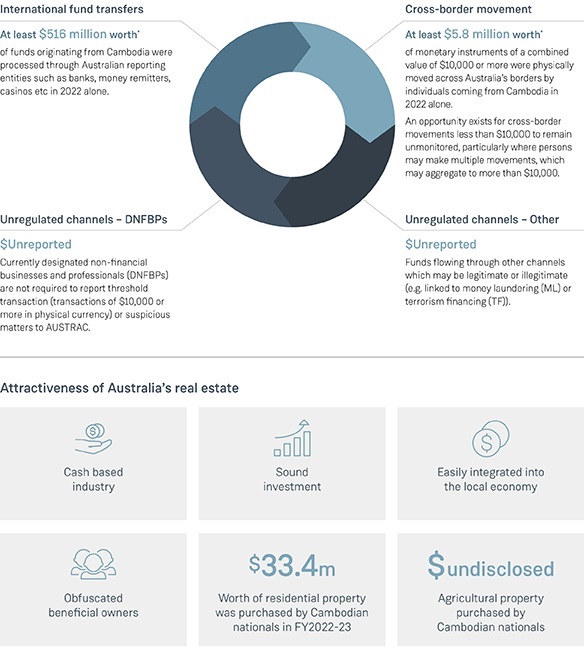Yesterday, the Attorney-General announced a boost to AUSTRAC's funding in the upcoming federal budget, to fund new reforms to Australia's AML/CTF regime.
The recently published second round consultation paper, 'Reforming Australia's anti-money laundering and counter-terrorism financing regime' ('Tranche 2' reforms'), proposes obligations under the AML/CTF legislation are extended to real estate agents, lawyers, accountants, trust and company service providers and dealers in precious metals and stones (collectively referred to as designated non-financial business professionals DNFBPs).
This announcement coincides with KordaMentha & Transparency International Australia's report into the money laundering vulnerabilities in Australia and Cambodia's AML/CTF regimes, and the factors that make Australia an ideal destination for regional foreign proceeds and illicit funds. This is of particular significance given Australia's real estate sector is worth three times the Australian stock market and is currently not subject to any AML/CTF obligations.
Reported funds flowing from Cambodia into Australia

Our research identified six key themes along with a range of mechanisms designed to address deficiencies or vulnerabilities with the current AML regimes:
1. Australia's AML/CTF regime is not compliant with the global standards and is not consistent with international peers.
AML/CTF legislative reform is required in Australia to capture all DNFBPs including the real estate sector and professional facilitators, in keeping with the ML/TF risk faced by those sectors.
- Legislative reform is required to expand Australia's AML/CTF framework, making it applicable to all DNFBPs and professional facilitators.
- A beneficial ownership register needs to be introduced and effectively used by practitioners. Australia must strike a balance between disclosing information to prevent ML/TF and the beneficial owners' fundamental rights, by considering a tiered approach to disclosing information. In keeping with FATF's guidance on beneficial ownership of legal persons, at a minimum some or all beneficial information should be made available to financial institutions and DNFBPs. Whereas public access information should be of a general nature.
- Regional and international focus on the effectiveness of Cambodia's AML/CTF framework is required to support its continued AML/CTF capability.
2. Australia has yet to assess the ML/TF risks faced by DNFBPs including the real estate sector
- An intelligence-led approach to the design of Australia's 'Tranche 2' regulatory framework, is required to ensure it is agile and responsive to technological innovation, emerging ML/TF threats and vulnerabilities.
3. Australia lacks key regulatory measures such as a property ownership register
- Effective and pragmatic AML/CTF regulation and supervision of Australia's real estate sector needs to be initiated.
- A register for property ownership should be created to improve transparency, accountability and mitigate risks, subject to privacy considerations.
4. Legitimate frameworks currently provide opportunities to obfuscate the true source of wealth, funds and beneficial owners for financial crime purposes
- Structural change should be considered as part of Tranche 2 reforms to consider the gaps identified in this paper to cover typologies such as shadow banking, land banking, and significant visa investment schemes.
- ML/TF risk should be considered as part of the significant visa investment (SIV) process, particularly during the proposal review stage.
- Source of wealth (SOW) and source of funds (SOF) requirements should be key to the changed legislation in relation to real estate agents given it provides critical information to understand the risks associated with real estate transactions.
5. Domestic and transnational partnerships should be better leveraged to achieve operational outcomes and harms reduction
- The broader role of Public-Private Partnerships and Private-Private Partnerships should be considered in the detection and prevention of ML.
- International collaboration between domestic, regional, and international collaboration, particularly with ASEAN and regional AML/CTF regulators and financial intelligence units (FIUs) should be enhanced.
- Investment in capacity-building initiatives is required to bolster the capabilities of Cambodia's AML/CTF regulators, FIU and reporting entity population.
6. Greater cooperation and partnership between Cambodia's reporting entities and law enforcement agencies (LEAs), and other relevant agencies is needed
- Current levels of criminal activity, ML and corruption originating in Cambodia will be very difficult to control and value is likely to flow across the broader ASEAN region.
To read the full report 'Stopping Dirty Money in Australia and Cambodia click here.
To read our previous Tranche 2 response click here.
To engage with the consultation process click here
The content of this article is intended to provide a general guide to the subject matter. Specialist advice should be sought about your specific circumstances.
We operate a free-to-view policy, asking only that you register in order to read all of our content. Please login or register to view the rest of this article.




